We have prepared a two-part blog explaining the “tricot” method and detailing the approach for on-farm testing for variety release (Part 1) and featuring the monitoring and inspection part with partners (Part 2).
Part 2 details the initial monitoring and inspection of tricot trials in collaboration with the National Varieties Release Committee in Nigeria.
Our breeding team at IITA and NRCRI, in collaboration with participating farmers, implemented on-farm testing as part of the varietal release process. Unlike traditional on-farm trials, these trials were evaluated by participating farmers at intervals of one, three, six, and nine months after planting to assess the genotypes’ performance prior to harvest. Following harvest, the trials will be further evaluated at multiple stages during processing into food products.
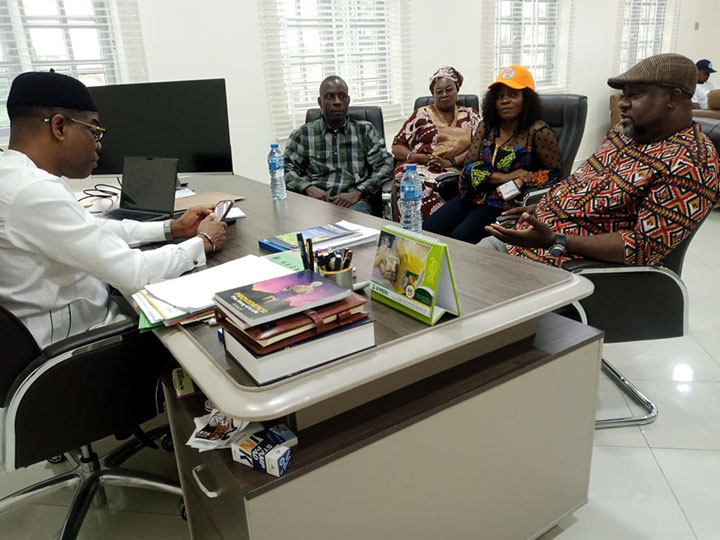
Courtesy call on the Executive Director/CEO NRCRI, Umudike by the NVRC. From the left is Prof. Chiedozie N. Egesi (ED/CEO NRCRI); Dr. Maxwell Okoye (NVRC); Dr.Tessy Madu (Director PME), Dr. Favour Okeakpu (Coord. Cassava Programme NRCRI); Dr. Anthony Okere (Director NACGRAB/Registrar NVRC. Photo credit: Samuel Onwuka
To ensure comprehensive evaluation and inspection of these trials as part of the official variety release procedure, we teamed up with the National Varieties Release Committee (NVRC) at the National Centre for Genetic Resources and Biotechnology (NACGRAB), to monitor and inspect the tricot trials nine months after planting. The monitoring took place between 4 and 7 June 2024. This initiative aimed at gathering first-hand feedback from farmers and ensure good engagement and ownership of the trials by the farmers
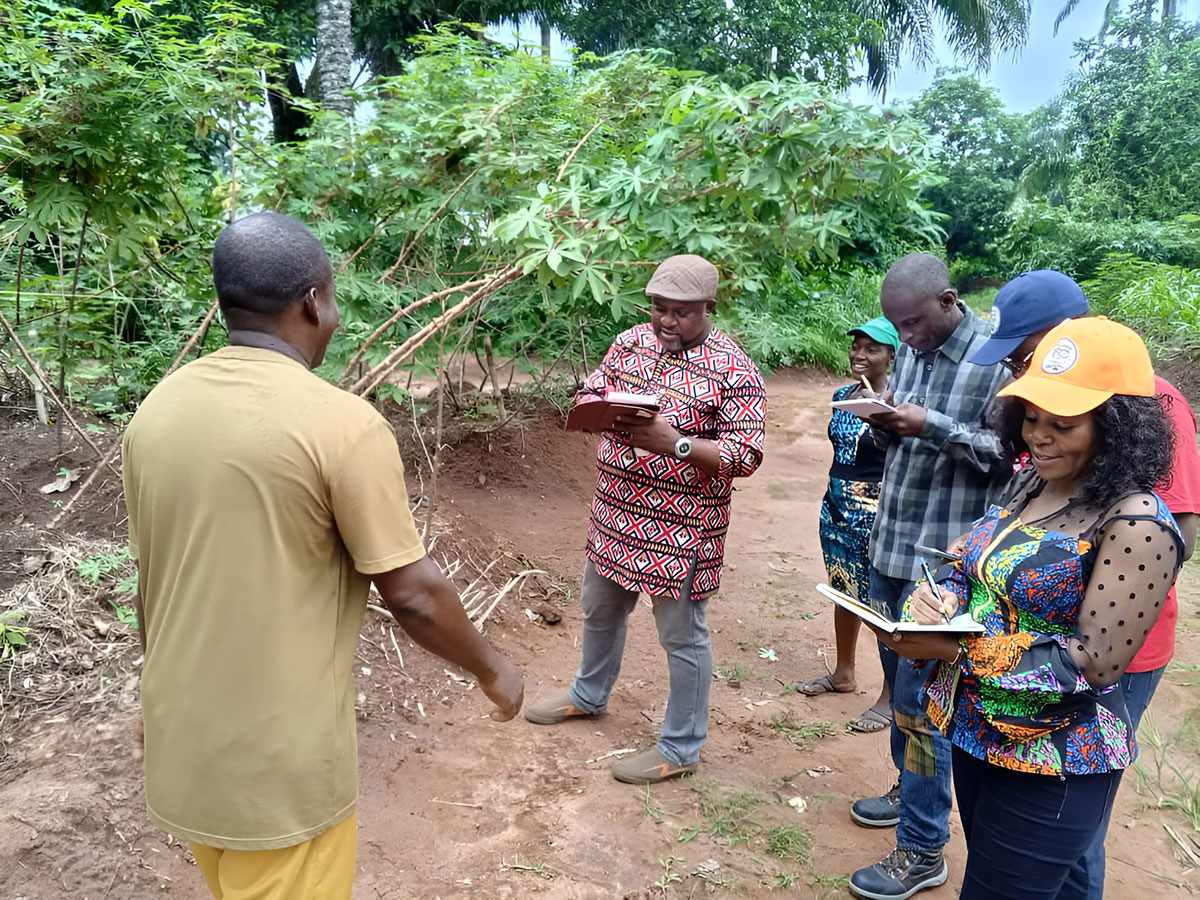
Dr. Anthony Okere and Dr. Maxwell Okoye, engaging with Mr. Chidi Mmeje; one of the farmers in Imo State. Photo Credi Dr. Samuel Onwuka.
The inspection visit in Oyo and Osun state was led by Ibidun Adetiloye, accompanied by Damian Njoku, Gloria Afolayan, Peter Iluebbey, and Abolore Bello. The inspection visit in Imo state was led by Anthony Okere, accompanied by Maxwell Okoye, Favour Okeakpu, Samuel Onwuka, and Sabestine Emengaha. In Oyo and Osun States 10 tricot trials were visited, involving four women and six men from the Agunrege, Owotoro, Ifon, and Okuku communities. In Imo eight tricot trials were visited engaging four men and four women from the Umualumaku, Umunakanu, Owerre, and Umuebu, communities.
Farmer feedback and genotype performance
During the visit, four men and three women farmers identified advanced genotypes as their top choice. Six others ranked the advanced genotypes as their second preference. Farmers highlighted several reasons for favoring advanced genotypes. Each of the farmers realized that their ranking could change significantly when reaching the harvest stage and postharvest stage evaluations. Key preferred traits included the ability to produce multiple stems, a highly desirable characteristic for cassava stem sellers aiming to produce early-generation seeds, good establishment, sturdy stem. and the ‘stay green’ characteristic.
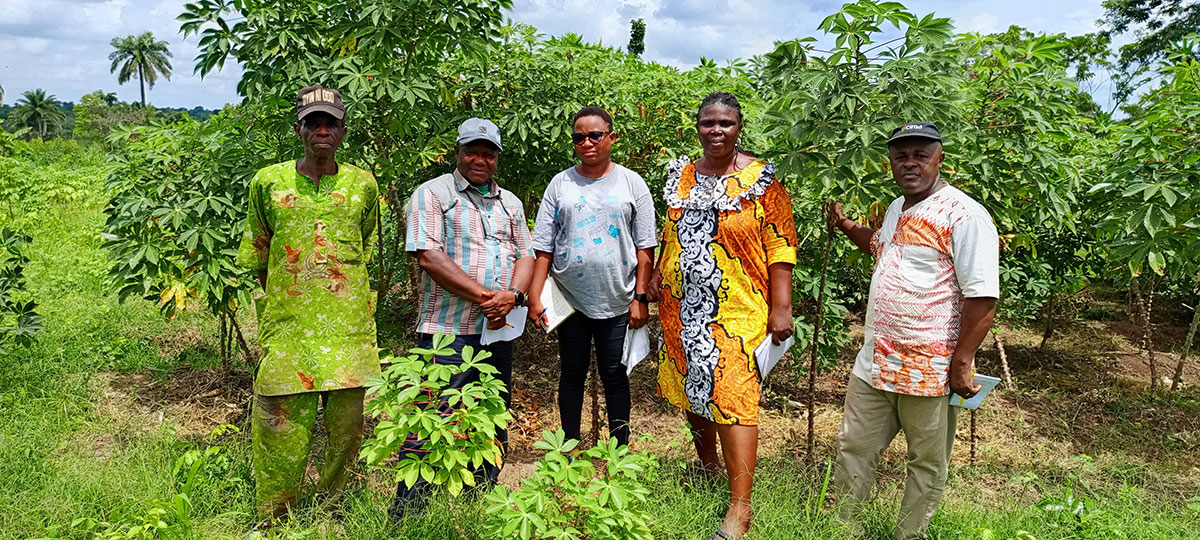
The team during inspection of a Tricot farmer’s field at Oke-Otin, Okuku, Odo-Otin LGA, Osun state. Photo Credit Bello Abolore.
Furthermore, farmers appreciated the genotypes’ protruding nodes with short intervals, good establishment, and canopy formation, which effectively suppresses weeds. The early signs of root formation, indicated by soil cracking, were particularly valued as they instilled confidence in the expected yield at harvest. One of the women tricot farmers did not just maintain a tricot trial, but also planted and managed her own cassava field beside it, showcasing all the best agronomic practices that she had previously learned as a citizen science partner during earlier tricot trials. This indicator of rapid adoption of technology, a strength of the tricot approach, was acknowledged and lauded by the leader of the visitation panel.
Post-monitoring discussion and recommendations
Following the monitoring exercise, we held a discussion to consolidate our findings and received valuable advice from the National Variety Release Committee. The variety release team was impressed by the state of the farms visited—they were well maintained and farmers were able to provide information on the trial set-up and respond to the questions asked by the variety release committee delegates. Farmers, together with the lead farmer, were able to convince the variety release committee of their keenness about the cassava in the trials. The lead farmers did the evaluation together with the farmers during the different evaluation moments. The farmers stated that handling a few cassava genotypes at a time makes it easier to maintain, observe, and remember the differences in the cassava varieties planted on their farms. The trial also created a social impact in the community as it made farmers come together to share experiences on the performance of different cassava varieties on their farms and how to provide solutions to challenges arising in their farms.
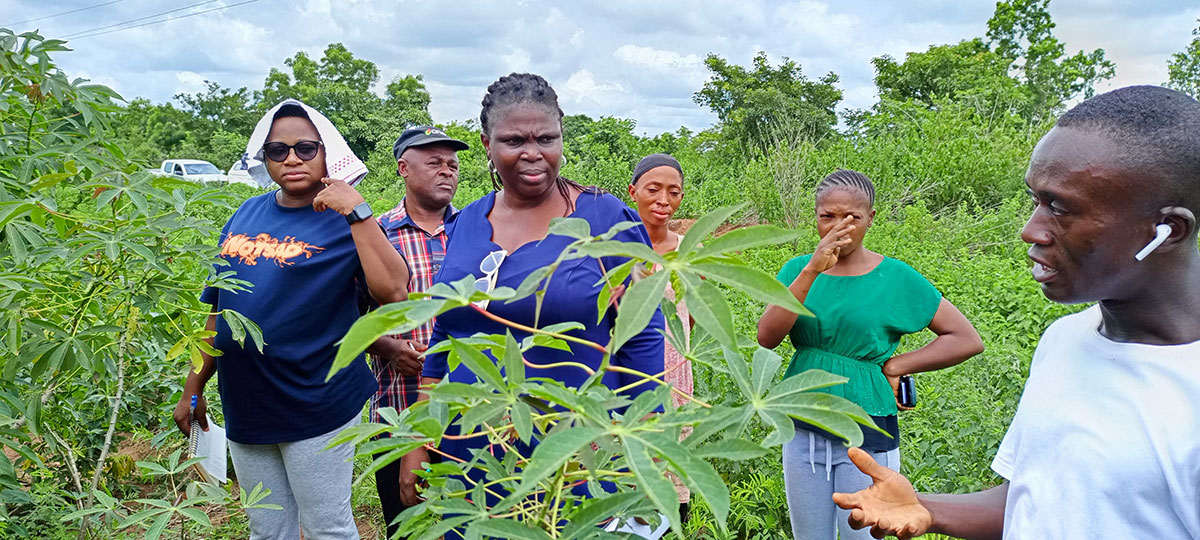
The inspection Committee discussing with Tricot farmers at Agunrege, Atisbo LGA, Oyo state. Photo credit Peter Iluebbey.
Farmers also stated that the hands-on training and information provided by the lead farmer on improved planting and processing techniques learned from research institute staff, have impacted their livelihoods and farming careers. The variety release committee recommended that our transdisciplinary team should enlighten farmers on the commercial names of evaluated varieties and checks. These names should be easy for farmers to pronounce and remember, ensuring consistency and preventing the proliferation of multiple or duplicate names by individual farmers or communities. This approach will facilitate effective tracking of released varieties as they diffuse across different agroecological zones. The committee indicated the need for a uniform nomenclature as this will speed up acceptance and suggested that farmers be asked to propose a name for their best varieties based on their unbiased assessment or discoveries made. The variety release committee also observed that the selection of the farmers was done with clear consideration of gender not only because we included men and women as individual farmers but also because we evaluated traits with them strongly related to gendered tasks, e.g., postharvest processing and food product evaluation was done by the person in the tricot participant’s household that possessed the skills and has the habit of carrying out this task. So, most processing and food product quality evaluation was done by women irrespective of the gender of the individual tricot participant. Another point of praise was the siting of the trials; the committee stated that trials should always be located where passersby can easily observe the technologies being showcased.
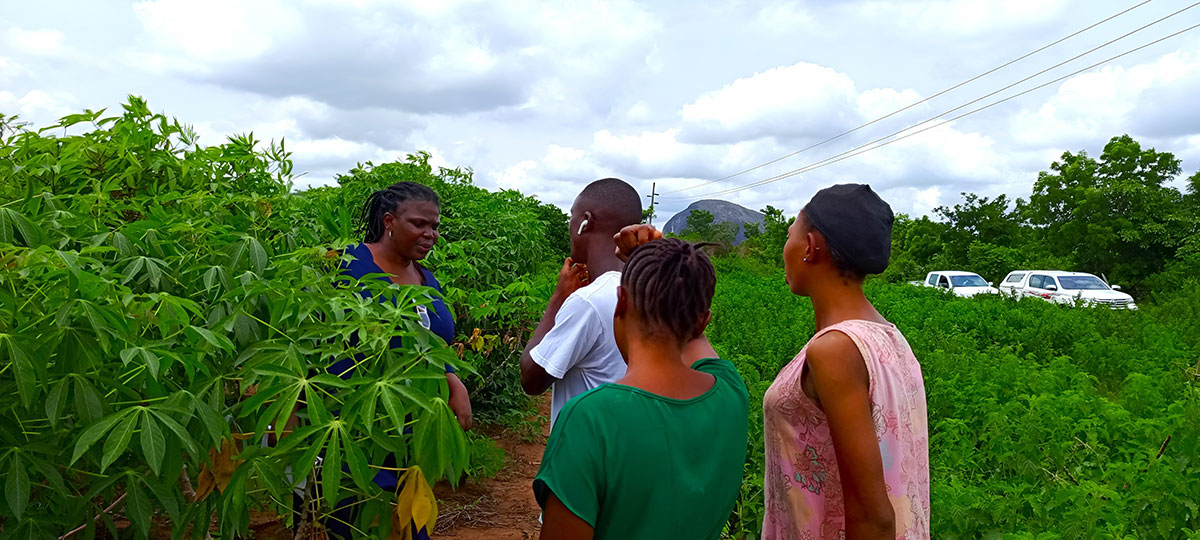
The team at one of the Tricot farmers’ farms at Agunrege, Atisbo LGA of Oyo state. Photo credit Peter Iluebbey.
The advice from the Committee underscores the importance of clear and consistent naming conventions for advanced and newly released cassava varieties. By ensuring that farmers easily identify and refer to these varieties, the breeding program can enhance the traceability and adoption of the genotypes across various regions.
Conclusion
The maiden monitoring and inspection of the tricot on-farm cassava trials mark a significant milestone in the cassava breeding innovation process. The collaboration between NRCRI, IITA, the Collaborative Seed Program and the National Varieties Release Committee, along with the active participation of farmers, displays the effectiveness of the tricot method in evaluating and selecting promising cassava genotypes that suit the livelihoods of farmers and processors.
As the program moves forward, the tricot data and recommendations gathered during this monitoring exercise will be used to refine the selection process, ensuring the successful release and adoption of high-performing cassava varieties. The strength of the tricot method is that it allows one to distinguish varietal and trait preferences, and their prioritization, across regions and different social and cultural dimensions while the tricot data can also be overlayed with climate data to see to what extent these explain part of the variance observed. This makes the tricot method relevant to climate change and assessing the external validity of breeding efforts and targeting social impact, a key objective of public breeding. The ultimate goal is to provide farmers with robust, high-yielding, and disease-resistant cassava varieties with excellent agronomic as well as food quality and processing traits as prioritized by men and women and that can thrive under diverse agroecological conditions, thereby contributing to improved food security, positive social and gender impact, and economic prosperity in Nigeria.
Future prospects
The successful implementation of the tricot method and the insights gained from this maiden monitoring and inspection exercise set a solid foundation for future advancements in cassava breeding and agricultural research. Tricot could also be a promising platform where breeders, variety release authorities, humanitarian NGOs, and the private sector can cooperate to create win-win scenarios that will facilitate more thorough human-centered co-design processes within breeding and seed systems. It can also link to other complementary innovations such as agronomic and organizational ones that can increase the impact of breeding efforts.
Authors
Abolore Bello (Senior Research Supervisor, IITA)
Olamide Olaosebikan (Senior Research Associate, IITA)
Samuel Onwuka (Principal Researcher and Development Expert)
Favour Okeakpu (Cassava Coordinator, NRCRI)
Benjamin Okoye (Senior Researcher and Market Production Specialist, NRCRI)
Tessy Ugo Madu (Research Director, NRCRI)
Béla Teeken (Associate Scientist, IITA)
Anthony Okere (Director NACGRAB and Registrar, NVRC)
Ibidunni Adetiloye (Desk Officer, NVRC)
Gospel Edughaen (Data Curation officer IITA)
Mercy Elohor Diebiru-Ojo (Cassava seed system specialist, IITA)
Ismail Rabbi (Head cassava breeding, IITA)
Elisabeth Parkes (Cassava breeder SAH, IITA)
Ukoabasi Ekanem (Breeding Data manager, IITA)
Esezobor Oke (Senior research supervisor, IITA)
Andrew Ikpan (Research support officer, IITA)
Peter Iluebbey (International trial manager, IITA)
Vishnuvardhan Banda (Product manager for crop variety development, IITA)
Ismail Kayondo (Cassava breeder, IITA)
Sikirou Mouritala (Cassave breeder, IITA)
Damian Ndubuisi (Cassava breeder, director NRCRI)
Mercy Ejechi (Social scientist, NRCRI)
Joseph Onyeka (Director of Research, NRCRI)
Solomon Afuape (Assistant director and sweet potato breeder, NRCRI)
Chiedozie Egesi (Executive Director/CEO NRCRI)
Peteti Prasad (Cassava Database programmer and Manager, IITA)
Ugo Chijioke (Food scientist, NRCRI)
Mercy Elohor Diebiru-Ojo (Cassava seed system specialist, IITA)

No Comments